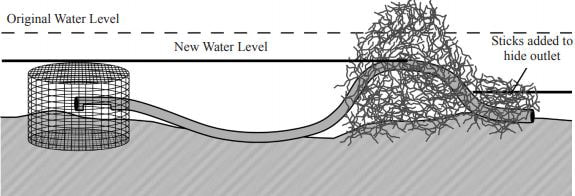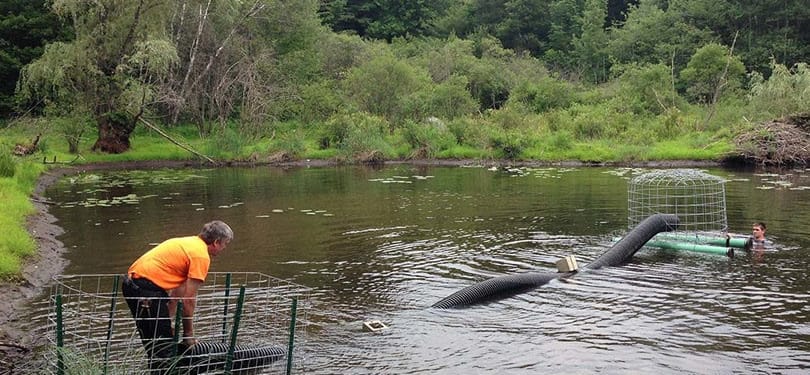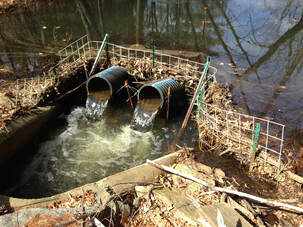Protect Against Flooding from Beaver Dams
At the end of the day, beavers thrive in wetland conditions. To make their home as comfortable and safe as possible, beavers build dams from sticks, rocks, and mud to create ponds. These ponds serve as both protection from predators, like wolves or coyotes, who cannot or will not traverse through water to eat them as well as provide the central location for beavers to build their homes, also known as 'lodges', to live in. Unfortunately, sometimes these beaver ponds can overflow into human communities, causing flooding of streets and homes. Luckily, there are also non-lethal, cost-effective methods that are proven to reduce flood risk.
|
Beaver flow devices can be utilized to help control beaver dams to protect against flooding. These flow devices are typically made of pipes and/or fencing. When properly built and installed, these systems will help protect human infrastructure while still allowing beavers to thrive and supply ecological benefits of wetland conditions.
|
How do flow devices work?
Flow devices allow for the coexistence between beaver homes and human communities. In using flow devices, beavers are able to continue living on the land while mitigating the potential for flooding impact that poses as a risk to some communities These work by creating a small, permeant hole in the beaver dam that they cannot repair. A piping system is inserted into the hole and through the dam structure so that flow of water is still permitted. The flow of water occurs naturally through the pipe by gravity. It is important, however, that these systems are installed as to not be detected by beavers who will want to 'repair' and fill in the hole. To ensure beavers cannot detect these systems, piping is placed at least three feet below the water and is surrounded by large, cylinder fencing. The level of the pipe is set to the level of water desired in the pond. It can also be readjusted at any time if one wants to raise or lower the pond water level.
If the water levels becomes lower than the system, the pipe naturally is unneeded and no water will flow through it so that water is retained for beaver use. Similarly, if there is an excess of water through things like a heavy storm, the water will simply run over the top of the dam during the storm, and once over, the piping system will filter out left over water from the pond to return it to its normal level prior to the storm.
It is important to not lower the level of water in a pond too much and only to a level that protects human interests. We must learn to coexist with beavers so that their ecological benefits and services are available to us and all other species. Similarly, lowering the water level too much may prompt beavers to build another dam, as they want to keep in as much water as possible, which would render the flow device ineffective. Usually lowering the water level by one vertical foot should not be an issue to beavers.
Of course, please be aware of your surroundings and terrain when looking to install a flow device. While beavers are not aggressive creatures, they do have an interest in protecting their homes much in the same manner as humans if someone were to break in and change some things around! In general, it is best practice to leave flow device construction up to professionally trained experts who both know how to properly install these systems so they are effective as well as how to handle beaver encounters if one should occur.
If the water levels becomes lower than the system, the pipe naturally is unneeded and no water will flow through it so that water is retained for beaver use. Similarly, if there is an excess of water through things like a heavy storm, the water will simply run over the top of the dam during the storm, and once over, the piping system will filter out left over water from the pond to return it to its normal level prior to the storm.
It is important to not lower the level of water in a pond too much and only to a level that protects human interests. We must learn to coexist with beavers so that their ecological benefits and services are available to us and all other species. Similarly, lowering the water level too much may prompt beavers to build another dam, as they want to keep in as much water as possible, which would render the flow device ineffective. Usually lowering the water level by one vertical foot should not be an issue to beavers.
Of course, please be aware of your surroundings and terrain when looking to install a flow device. While beavers are not aggressive creatures, they do have an interest in protecting their homes much in the same manner as humans if someone were to break in and change some things around! In general, it is best practice to leave flow device construction up to professionally trained experts who both know how to properly install these systems so they are effective as well as how to handle beaver encounters if one should occur.



